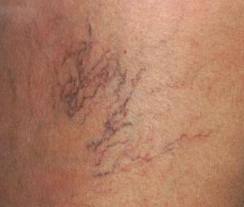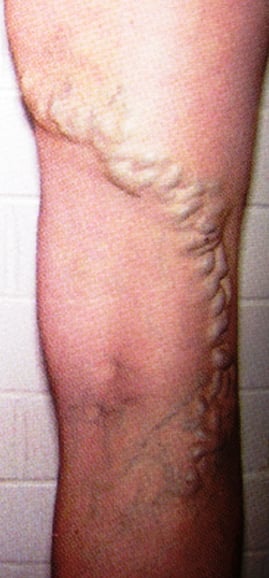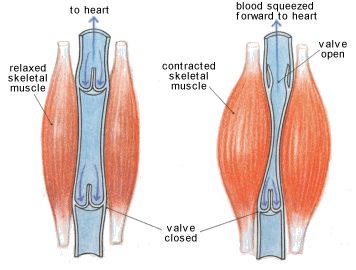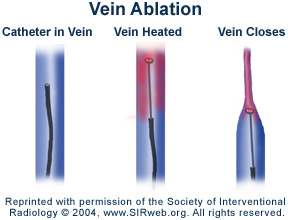

Varicose Veins....an ugly term for an ugly and troublesome condition. Almost everyone remembers a relative that had or has hideous looking legs. When they show them, the kids run for the hills. Today, I would like to discuss why the problem occurs and what can be done about it. Also, a little history to show you how things have changed.....they are a whole lot better today!!
Varicose veins are a wastebasket term for chronic venous insufficiency. Both are big descriptions for a complex problem. The issue can range in severity from small spider veins, which most people have a smattering of, to the big ropey veins, to swelling in the lower legs, skin color changes and even leg ulcers that won't heal.
 A picture of spider veins.
A picture of spider veins.
 Picture of large varicose vein.
Picture of large varicose vein.
To be nice, I won't show an ulcer, they are ugly!!
The cause of these problems are usually hereditary, but can occur from leg injuries, clotting in the legs, and other factors. They are made worse by working conditions, pregnancy, but usually not caused by them. Of course, the human vascular system starts with the heart. It pumps blood rich in oxygen to the rest of the body. The blood travels around and exchanges oxygen for CO2 (the byproduct of the cells working), it then must get back to the lungs for the exchange of CO2 for new oxygen and the process repeats. The veins don't have the heart to pump the blood, so, the musculature of the extremities compress the veins and make the blood move towards the chest and lungs. In the normally functioning vein, there are valves present that allow the blood to only go towards the chest....up....against gravity that wants it to go down. In the diseased vein, these valves don't work and the blood pools and stays in the leg or arm. These pictures are a good visual for how this works.
These pictures are a good visual for how this works.
 If the valves do not work properly, pressure builds. This is reflected in the branches of the larger veins and they enlarge over time creating the large varicose veins we have all seen. These become painful as they stretch the surrounding connective tissue and the pressure, combined with the lack of flow causes the iron from the blood to break down in the skin. This can lead to rust colored changes in the skin, rashes, and eventually skin breakdown.
If the valves do not work properly, pressure builds. This is reflected in the branches of the larger veins and they enlarge over time creating the large varicose veins we have all seen. These become painful as they stretch the surrounding connective tissue and the pressure, combined with the lack of flow causes the iron from the blood to break down in the skin. This can lead to rust colored changes in the skin, rashes, and eventually skin breakdown.
Treating this problem has changed significantly in the last decade or so. Since the problem is usually the saphenous vein (kind of an intermediate vein in the leg), we used to remove it surgically and called it stripping. Many have heard horror stories about removing these veins, having general anesthesia and the recovery time required. With modern ultrasound and laser technology we can now remove this vein from the circulation without stripping, without general anesthesia, and without a long recovery time......great news!! We do them in the office, patients walk, in then walk out. There is almost no down time...if any.

For the large, tortuous, ugly branches, we remove them through tiny incisions, as small as the end of a pen. Because we have stopped the flow into this vein by lasering the saphenous vein there is very little blood loss and again, almost no down time. The little incisions heal nicely and are not noticed after a few months.
Most of the time, if you are having symptoms of pain, swelling, skin color changes and have a visible varicose vein, insurance will pay for the procedure...after jumping through a few hoops. Spider veins are considered cosmetic and are not covered though we can treat them with injections or laser.
So if you have vein issues, come see us today at Total Body Surgical where we can help. Our goal is to try to make your legs look and feel as normal as possible. Call 918-786-7780 today!!

